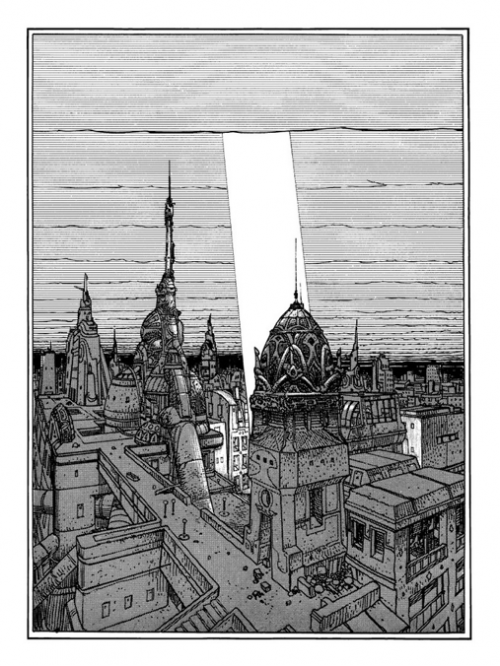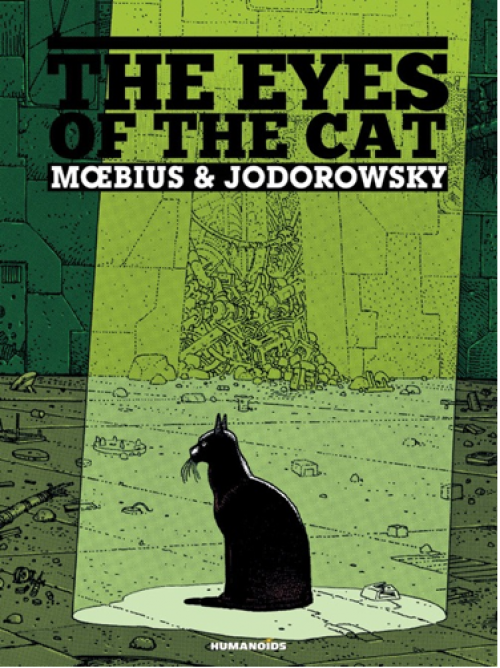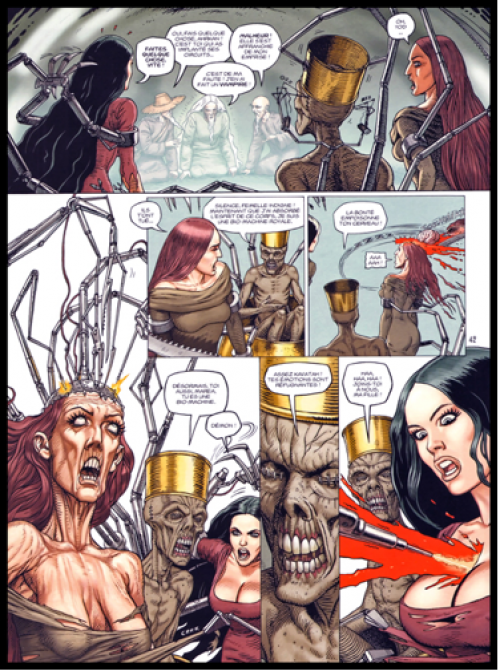Looking for more bande dessinée lunacy? Then read on…
Recently I reviewed The Incal, the epic psychedelic space opera from the all-round holy madman Alejandro Jodorowsky and French comics master Moebius. It is, as I said, good to a consciousness-scrambling degree. But Jodorowsky has many other works available in English, and today I draw attention to two of them, one of which dates from the beginning of his comics career and the other of which appeared at what we must assume is close to the end of it, given that he is now 83. Connoisseurs of lunacy take note.
Eyes of the Cat was not Jodorowsky’s first comics work- he had written and illustrated strips published in Mexico in the 1960s- but it was his first big splash in the French market where he was to make his living after the collapse of his film career in the late 70s. Like The Incal, it is a Moebius collaboration, and was originally released in digest size on garish yellow paper as a freebie by the French publisher Les Humanoides Associes, to reward subscribers to their trippy SF magazine Metal Hurlant. It soon became a collector’s item, changing hands for lots of money, and has been released in numerous iterations over the last thirty years. In English it first appeared on yellow paper inside the long defunct horror anthology Taboo, and then twenty years later was reissued by the LA-based arm of Les Humanoides in an incredibly expensive luxury format that sold out in approximately 20 seconds (or something like that). Now Eyes of the Cat is back again, this time in tabloid size on heavy white paper stock.
Alright, you format fetishist, but what’s it about? Well it’s difficult to explain because the story is so short and simple that the briefest description risks giving the game away. In his introduction, Jodorowsky explains that Moebius himself complained that there was only enough content for a five pager, not an entire book. Jodorowsky’s solution was to take each panel and treat it as a full-blown illustration, faced each time by an (almost) static panel of a boy standing in a tower in silhouette with his back to us. Et voila! You have a fifty page book.
And now, the “plot”: in a seemingly abandoned city that is rotting and crumbling, a cat emerges from the shadows to stretch itself in a lone beam of sunlight. At the order of the boy in the tower, Meduz the Hawk attacks. I won’t tell you what happens next, although I will say that what on the surface seems like gross-out horror is actually a dense, resonant, symbolic something-or-other that feels a little like a poem, a little like a parable, a little like a riddle, and a little like an isolated sequence from a long nightmare. Very few words are used, and although the new translation is much more poetic than the original cheesy yellow paper version in Taboo, I am not at all certain that it is an improvement.
Fortunately this doesn’t really matter: Jodorowsky is a trained mime, and the words are barely necessary. Meanwhile the story is so beautifully drawn that you can return to it again and again, for Eyes of the Cat is truly a thing of beauty, an object to be lingered over at length, located somewhere on the border of comics and fine art, as if Albrecht Durer had reemerged to work in the unlikely milieu of late 70s pessimistic French-Chilean mystical sci-fi horror (but let it stay on the border, and not cross over into that dreary other world, please). Indeed, so delighted was Jodorowsky with Moebius’ work that he tells us that every evening he would drive thirty miles each way from his house to Moebius’ place to see each finished panel, with the result that he dedicated “1500 miles of hours on the road in honour of “The Eyes of the Cat”.” It’s a fitting tribute.
So that was Moebius and Jodorowsky’s first collaboration; but after Eyes of the Cat came hundreds of pages in the form of The Incal and The Madwoman of the Sacred Heart while Jodorowsky produced thousands more pages with other artists, hopping from genre to genre, blending the sacred with the sexual and scatological, the divine with the absurd. And thus thirty years later we find ourselves staring at the strange creature that is Megalex – a collaboration with artist Fred Beltran, the majority of which was drawn on computer, and which is as dense and overblown as Eyes of the Cat is sparse and minimal.
Megalex is the story of a planet where the permanently stoned citizens live in an entirely man made environment, entertained by cruel spectacles, and where “anomalies” are exterminated without mercy. Dig the satire, man. Unlike the sparse and minimalistic Eyes of the Cat it is written in Jodorowsky’s much more familiar overdriven style, whereby a profusion of mad ideas are crammed into each panel; plot twists and deus ex machinas are thrown around with abandon; and a scurrilous sense of humor collides with an ultimately overwhelming undercurrent of New Age mumbo-jumbo. There are freaks, colossal breasts, robots, mutants, wicked parents, an underground resistance struggling against evil and then (as the art switches from computer-generated to hand-drawn) a great deal of spiritual enlightenment and soul-healing.
The problem with Megalex is that much as it is mad, it is in many ways derivative of the first book of The Incal: the drug-addled populace in an entirely artificial environment; a sub-class of freaks; and an androgyne that heals, all appeared in one form of another in the earlier series, but unlike that psychedelic epic, Megalex does not explode outward in every direction. Rather, the third section feels very rushed, as if Jodorowsky and Beltran had originally planned to extend the story over multiple volumes but suddenly decided to tie up all the loose ends very quickly. The result is a fairly flat parable about man and nature and male and female principles living in harmony that feels almost- shockingly- conventional. It is still Jodorowsky, so it is by no means boring or otiose, though it sits far down the list of “essential” works.
But do the early masterpiece and the late period minor work have anything in common? They are separated by decades, split asunder by tone, content, genre, artists, nearly everything you can think of. And yet both posit weird future environments, dead worlds without vegetation or organic life, populated by children without parents, who are searching for some kind of wholeness. In Eyes of the Cat even the clothes of the boy are rotting, while his skin (in an area of great significance for the plot) is cracked and crumbling. He is young without youth; how long has he been standing in the tower? What does he eat, how does he live? In Megalex we meet an ancient, wizened, inhuman king who has cursed his own daughter to a form of eternal life that denies her human contact; though she seems young, she is in fact ancient, a prisoner of her own flesh. But whereas in Megalex the regeneration comes and is completely unpersuasive, in Eyes of the Cat it is denied. There is only decay, violence, death, and a futile game, forever and ever, amen. Although at one point Jodorowsky was talking about writing a sequel…














…The Incal, the epic psychedelic space opera…
Much obliged, Daniel. Reviewers who tell me in their very first sentence why I would likely detest something are worth their weight in gold.
You might desest it, or you might discover that it is beautifully drawn and very, very funny- even the cosmic bits.
“detest” obviously.
Seems almost scarily obtuse and very very French. I’d be up for giving one a go though, been a while since I read a good graphic novel. There’s a chap I talk to occasionally on twitter who does ‘abstract comics’ which seem to have no plot and to be page after page of psychadelic swirly things and pictures of people falling into vortexes and the like
Fear not, they’re not obtuse at all- Megalex is excessively dense with plot, while Eyes is simple as a fable.
Perhaps I should have said bewildered, Daniel. I’m not quite such a philistine that I would dismiss the new and unfamiliar so summarily, but the very phrase “epic psychedelic space opera” reminded me that I am now at an age where I there is a growing disconnect between me and what is going on out there, and I frequently shake my head in confused alarm at what the kids are up to these days. The number of best sellers and film trailers I’ve seen recently featuring bizarre combinations of sci-fi and history ( Ulysses battles the aliens!) has for me changed the phrase “civilization as we know it” from one of parody to a constant preoccupation.
What I am wondering is whether this kind of cranky dismissal is a sign of age-appropriate maturity that will ultimately contribute to grounding the young and whether those old wrinklies who eat this stuff up and like to sit in the front row and give ostentacious standing ovations to are the ones in denial. I tend to think so, but then I would, wouldn’t I?
Top comment!
I can see where you are coming from, Peter. In my late 30s I increasingly find myself massively indifferent towards a lot of UK/US cultural output, and indifferent about my indifference. On the other hand, perhaps there is something cultural going on here- France is home to many very sophisticated cartoonists, and the BD form has long been taken more seriously over there than in the UK. There’s a cartoonist called David B. whose work is extraordinarily complex.
He doesn’t work in genre fiction however, which is what I like about the Jodo-Moeb collaborations- they teeter on the border of the ridiculous and deploy a lot of SF conventions but are very very far from Star Wars infantilism. Rather they take a “trash” genre and use it as a vehicle for all kinds of philosophical- metaphysical speculation, much in the way (say) Raymond Chandler took noir and used it for his own ends. Only Jodorowsky is much funnier.
“[E]pic psychedelic space opera” is surely redolent of the early-70s? Peter, even you must have been, er, less old back then?
Funnily enough, Gaw, for reasons I no longer recall, my love of popular music shifted focus abruptly to classical about 1972 and stayed there tenaciously for the rest of the decade. To this day I have trouble remembering whether Fleetwood Mac was a band or a make of lorry. Fortunately friends and family arranged an intervention and brought me back in time for disco.